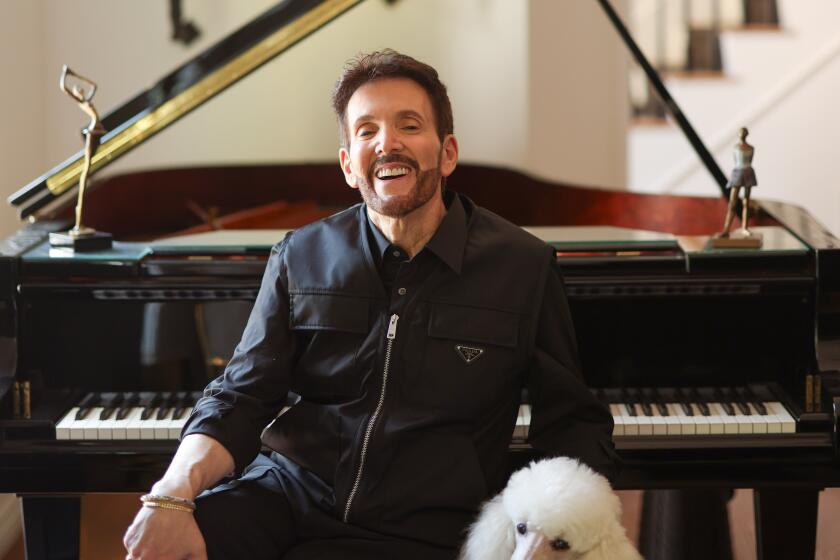Finding Harmony in Paradox
When the Los Angeles Philharmonic announced last year that it had commissioned a new work from Gerard Grisey, Esa-Pekka Salonen called the 49-year-old French composer one of the leaders of “the so-called spectral movement,” and went on to explain that musique spectrale is an attempt to create a new kind of harmony by analyzing the tonal spectra, or the overtone series.
The Philharmonic undoubtedly knew it would have days like that. After all, it has a music director who is an inquiring intellectual and a modernist composer himself, however difficult it may be to sell that side of him.
But a conversation on the phone with Grisey, still a bit jet-lagged from his flight to Los Angeles, reveals a lively and surprisingly amusing attitude toward work that can seem pretty esoteric. It turns out that rather than foisting dry music theory on Music Center audiences tonight with the premiere of “L’Ico^ne Paradoxale,” the Philharmonic just may be opening a big can of fat, juicy postmodernist worms.
The “Paradoxical Icon” of Grisey’s title is actually a very beautiful early Renaissance fresco. “If you look carefully at the Virgin,” he says of Piero della Francesca’s “La Madonna del Parto,” “you see her opening her skirt. The gesture tells [the viewer] that the origin of life is not what the two angels in the painting have shown, but the womb.”
But “paradox” is also a postmodern buzzword, and as Grisey begins to describe his involvement with the painting and the world it represents, the levels of paradox begin to multiply.
Grisey, who spent many summers in Tuscany and Umbria, describes his first acquaintance with the Francesca mural as a sort of mysterious discovery.
“It was in a chapel in a very small town of Monterchi in central Italy,” he says. “You had to go to a farmer and get a key to the church, then get in your car and drive through the woods to try to find the church. And there this great work would suddenly be. Afterwards, you lock the church and drive back to the farmer and give him the key.”
But not anymore. “The town realized that it could make some money off this work, so it has now built an awful modern building, put it behind glass.” Worse, though, is that the permanent installation also includes background music--Orff’s “Carmina Burana.”
This almost quintessentially postmodern commercialization of the quattrocento is, for Grisey, “a sign of a kind of cultural catastrophe occurring in the entire world.” But that doesn’t mean that Grisey himself doesn’t appropriate the past in his own creative way.
*
“I have always been fascinated by this period, the point in the Renaissance when artists started dealing with perspective and with space and time,” Grisey explains. “It might be a little bit dangerous to make this comparison, but that is what we were thinking about when, a few years ago, a few friends and I started this idea of spectral harmony as the beginning of a way in which art and science can be combined.”
For Grisey, the way the microphone has changed our perception of the content of sound is analogous to the way perspective in painting added insight to visual matters in the 15th century.
“Through analysis with microphones,” he contends, “we could realize what a sound was made of. So it was no longer possible to use sounds as abstract objects, but more now like living ones. It is the difference between dead fish in a can and living fish free in the water. Sounds are like biological beings, having birth, life and death.”
How we experience those living sounds is related moreover to modern relativistic perspectives about time and space. “I always give the example of whales singing,” Grisey continues. “You have a feeling of an extremely extended sound, and it is hardly possible for us, in our time frame, to connect one sound to the next, but the whales probably do. Now imagine how birds hear our speech. Their time is so fast that they may feel the words we speak have no connection.”
All of these notions find their way into “L’Ico^ne Paradoxale.” Sounds and language are spectrally analyzed and recreated through instrumental and vocal effects. The ensemble, and the singers--soloists Lucy Shelton, soprano, and Janice Felty, mezzo soprano--are divided unconventionally onstage to help make audible the various kinds of musical explorations taking place, as the music proceeds in different time frames simultaneously.
Yet the paradoxes do not cease even there. For all his involvement in science--Grisey says he likes nothing better than having discussions with his astrophysicist friends--he is no scientist, and he says he isn’t even comfortable with a computer.
And for all his jargon and use of spectral analyses, Grisey wants his music to take aim at the kind of inaudible structuralist complexity that has so long been associated with musical modernism.
“One should be able to grasp something of all this, to perceive it in the music,” Grisey says, sounding downright neo-Romantic. “And I’m very much concerned that the audience realize this. I hate it when a composer describes things in a piece that you can’t hear.”
* “L’Ico^ne Paradoxale,” Dorothy Chandler Pavilion, Music Center, 135 N. Grand Ave., (213) 365-3500. 8 p.m. Also, Friday and Saturday, 8 p.m. $6-$58.
More to Read
The biggest entertainment stories
Get our big stories about Hollywood, film, television, music, arts, culture and more right in your inbox as soon as they publish.
You may occasionally receive promotional content from the Los Angeles Times.











